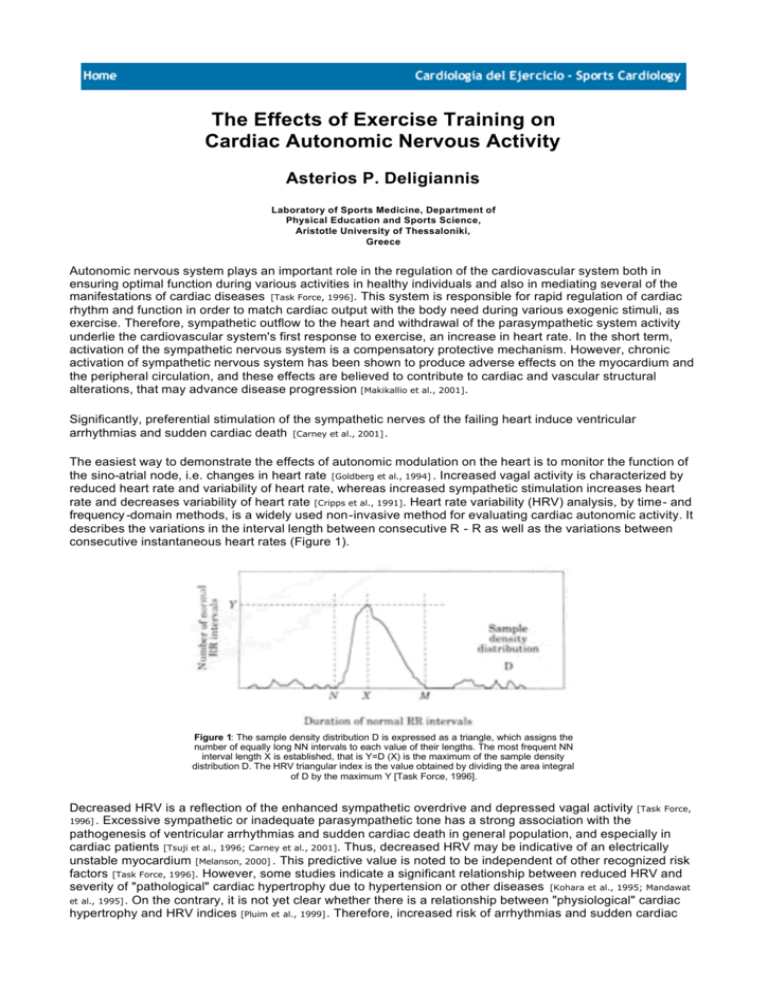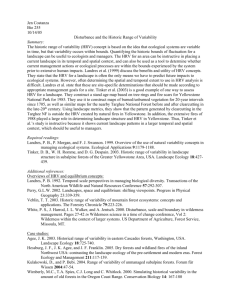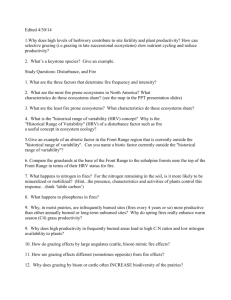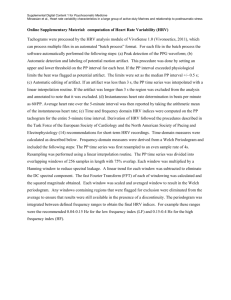The Effects of Exercise Training on Cardiac Autonomic Nervous
advertisement

The Effects of Exercise Training on Cardiac Autonomic Nervous Activity Asterios P. Deligiannis Laboratory of Sports Medicine, Department of Physical Education and Sports Science, Aristotle University of Thessaloniki, Greece Autonomic nervous system plays an important role in the regulation of the cardiovascular system both in ensuring optimal function during various activities in healthy individuals and also in mediating several of the manifestations of cardiac diseases [Task Force, 1996]. This system is responsible for rapid regulation of cardiac rhythm and function in order to match cardiac output with the body need during various exogenic stimuli, as exercise. Therefore, sympathetic outflow to the heart and withdrawal of the parasympathetic system activity underlie the cardiovascular system's first response to exercise, an increase in heart rate. In the short term, activation of the sympathetic nervous system is a compensatory protective mechanism. However, chronic activation of sympathetic nervous system has been shown to produce adverse effects on the myocardium and the peripheral circulation, and these effects are believed to contribute to cardiac and vascular structural alterations, that may advance disease progression [Makikallio et al., 2001]. Significantly, preferential stimulation of the sympathetic nerves of the failing heart induce ventricular arrhythmias and sudden cardiac death [Carney et al., 2001] . The easiest way to demonstrate the effects of autonomic modulation on the heart is to monitor the function of the sino-atrial node, i.e. changes in heart rate [Goldberg et al., 1994] . Increased vagal activity is characterized by reduced heart rate and variability of heart rate, whereas increased sympathetic stimulation increases heart rate and decreases variability of heart rate [Cripps et al., 1991]. Heart rate variability (HRV) analysis, by time- and frequency -domain methods, is a widely used non-invasive method for evaluating cardiac autonomic activity. It describes the variations in the interval length between consecutive R - R as well as the variations between consecutive instantaneous heart rates (Figure 1). Figure 1: The sample density distribution D is expressed as a triangle, which assigns the number of equally long NN intervals to each value of their lengths. The most frequent NN interval length X is established, that is Y=D (X) is the maximum of the sample density distribution D. The HRV triangular index is the value obtained by dividing the area integral of D by the maximum Y [Task Force, 1996]. Decreased HRV is a reflection of the enhanced sympathetic overdrive and depressed vagal activity [Task Force, 1996] . Excessive sympathetic or inadequate parasympathetic tone has a strong association with the pathogenesis of ventricular arrhythmias and sudden cardiac death in general population, and especially in cardiac patients [Tsuji et al., 1996; Carney et al., 2001]. Thus, decreased HRV may be indicative of an electrically unstable myocardium [Melanson, 2000] . This predictive value is noted to be independent of other recognized risk factors [Task Force, 1996]. However, some studies indicate a significant relationship between reduced HRV and severity of "pathological" cardiac hypertrophy due to hypertension or other diseases [Kohara et al., 1995; Mandawat et al., 1995] . On the contrary, it is not yet clear whether there is a relationship between "physiological" cardiac hypertrophy and HRV indices [Pluim et al., 1999] . Therefore, increased risk of arrhythmias and sudden cardiac death associated with left ventricular hypertrophy (LVH) has focused attention on assessment of cardiac autonomic disturbances in subjects with increased LV mass. It is widely presumed that regularly performed aerobic exercise induces adaptations in the cardiac autonomic nervous system that alter cardiovascular variables at rest and/or baroreflex circulatory control [Dixon et al., 1992] . Aerobic exercise training leads to enhanced vagal activity at rest, which may contribute in part to the resting bradycardia [Shi et al., 1995; Shin et al., 1997; Goldsmith et al., 1992; Jensen-Urstad et al., 1997; Strano et al., 1998] . Several studies using time domain and/or frequency domain analysis of HRV have reported beneficial effects of welldesigned aerobic training programs on cardiac autonomic influences in athletes and sedentary subjects, as well as in cardiac, dialysis or diabetic patients [Task Force, 1996; Osterhues et al., 1997; Deligiannis et al., 1999]. In our recent studies, long distance runners and soccer players reached higher values of HRV and had the lower 24h resting mean heart rate compared to other athletes and to sedentary subjects according to the 24-h Holter recordings [Kouidi et al., 2002, endelides et al., 2003] (Figure 2,3). Figure 2: HRV triangular plot in a marathon runner (a) and a sedentary age-matched healthy individual (b). Figure 3: HRVI in athletes of various sports Similar improvements in HRV in endurance trained athletes have been demonstrated from other studies, while controversial results were reported for athletes participating in other types of training, as anaerobic or strength training [Reiling & Seals, 1988; Furlan et al., 1993; Shi et al., 1995; Macor et al., 1996; Shin et al., 1997; Bonaduce et al., 1998; Pigozzi et al., 2001] . Intensity and duration of physical training, age, gender, degree of previous exposure to training stimuli, the level of cardiorespiratory adaptations, the emotional status and methodical differences in the assessment of HRV, in various combinations may have a bearing on the question [Melanson, 2000; Pluim et al., 1999; De Meersman, 1993; Sacknoff et al., 1994; Dishman et al., 2000; Perini et al., 2000; Boushel et al., 2001; Hedelin et al., 2001] . In our studies, significant relationship was found between the level of maximal oxygen uptake and HRV in long-distance and soccer athletes [Kouidi et al., 2002; Sendelides et al., 2003] (Figure 4). Figure 4: Scatter plot of heart rate variability index (HRVI) and maximal oxygen uptake (VO2max) in 15 male long distance athletes (r = 0.61, p<0.05). There are few previous data that confirm this relationship [Shin et al., 1997; De Meersman, 1993; Boutcher & Stein 1995]. It is well known that increase in VO 2max is consequence of endurance training, as result to cardiac and peripheral adaptations. Thus, it is possible that the improvement of aerobic capacity acts beneficially on the cardiac autonomic outflow, as indicated by increased HRV [Seals and Chase, 1989; Goldsmith et al., 1992; Deligiannis et al., 1999; Hedelin et al., 2001]. However, Melanson supported that although HRV may be greater in active than sedentary men, any measure of HRV does not appear to be correlated with increasing levels of physical capacity [Melanson, 2000] . Furthermore, it is not well known whether there is a relationship between the magnitude of parasympathetically mediated modulations in HR and vagal tone or bradycardia [Melanson, 2000] . Maciel et al supported that HRV at rest was similar in endurance athletes and their sedentary peers, in spite of a significantly lower heart rate in athletes [Maciel et al., 1985] . Other references also showed the presence of low levels of HRV despite the high level of vagal tone [Malik & Cramm 1993; Goldberger et al., 1994]. The apparent discrepancy may be due to the support that time domain measurements of HRV analysis would appear to be markers of modulations in cardiac parasympathetic activity and not vagal "tone" [Melanson, 2000; Goldberger et al., 1994] . Moreover, it is demonstrated that the endurance athletes' bradycardia is also mediated by decreases in sympathetic tone and by nonautonomic "intrinsic" mechanisms [Seals and Chase, 1989] . In our study increased heart rate variability was also observed in sprint track and weight field athletes in comparison to sedentary subjects [Kouidi et al., 2002] . However, there was no relationship between HRV and VO 2 max in these athletes. It seems that the type of exercise is not the only responsible factor for the cardiac autonomic modulation. This suggests that some other mechanisms, except of aerobic adaptations, could be included in determining the profound cardiac vagal control of athletes [Seals and Chase, 1989; Hedelin et al., 2001]. On the contrary, other reports have failed to demonstrate such an increase in HRV indices in anaerobic- and strength- trained athletes [Reiling & Seals, 1988; Furlan et al., 1993; Bonaduce et al., 1998; Boutcher & Stein, 1995]. This may be in part due to insufficient training duration of the athletes to develop significant cardiac autonomic modulation. The adaptive changes in the cardiac structures taking place under the influence of exercise training was found to have no relationship with HRV in athletes. A positive correlation was found between HRV and EDV only in long distance runners in our study [Kouidi et al., 2002] . This relationship between HRV and volume overload may partly be explained by the lower resting heart rate in endurance athletes. Our results are in agreement with the findings of Pluim et al, who supported that increased HRV in elite cyclists was independent from the extent of myocardium mass [Pluim et al., 1999] . Moreover, the authors demonstrated relations between mean NN and RMSSD and LV diastolic function indices, partly as result of enhanced vagal tone and subsequent bradycardia. On the other hand, recent studies reported a significant negative correlation between reduced HRV and the magnitude of "pathological" LVH due to cardiovascular diseases [Tsuji et al., 1996; Kohara et al., 1995; Mandawat et al., 1995; Piccirillo et al., 1996] . Myocardial hypertrophy has been shown to be an extremely strong predictor of morbidity and mortality in the general population [Levy et al., 1990; Kannel, 1996]. The above may suggest that "physiological" LVH in athletes has not a proven augmented risk for sudden cardiac death [Pluim et al., 1999]. Endurance training-induced enhancement of parasympathetic activity may attribute to a reduction of the risk of sudden cardiac death, especially in patient populations considered at increased risk at fatal arrhythmias. As mentioned previously, measurement of HRV has considered as a prognostic marker of the risk for future arrhythmic events among cardiac and other patients. Decreased HRV has been associated with four fold increased risk for sudden cardiac death in patients with coronary artery disease, chronic heart disease, endstage renal disease on hemodialysis and other chronic conditions and is significantly associated with all-cause mortality in the general population [Cripps et al., 1991; Deligiannis et al., 1999; Makikallio et al., 2001] . It has also been demonstrated that increased vagal stimulation to the sinoatrial node decreases vulnerability to ventricular fibrillation in coronary patients [Kupari et al., 1993; Moser et al., 1994]. An unanswered question is whether enhanced HRV following training is an evidence of a cardioprotective effect of exercise [Melanson, 2000; Osterhues et al., 1997] . It is interesting to note that HRV is authorized as a marker of cardiac autonomic activity only, and not a direct measure of myocardium electrical stability, which has the most important role for arrhythmic events [Task Force, 1996] . A recent experimental study, designed to assess the effects of physical training on markers of cardiac vagal activity during acute myocardial ischemia suggested that exercise training increases HRV and thus confers anticipatory protection from occurrence of ventricular fibrillation [Hull et al., 1994]. There are data available regarding the effects of exercise training on HRV in patients with coronary artery disease, chronic heart failure, end-stage renal disease and other. It is supported that physical training enhances overall autonomic control in chronic heart failure, both vagal on the heart and sympathetic on the peripheral vessels [Radaelli et al., 1996; Deligiannis et al., 2002] (Figure 5, 6). Figure 5: Spectral HRV analysis in patients with chronic heart failure before and after 6 months of exercise training Figure. 6: SDNN measurements in patients with chronic heart failure before and after 6 months of exercise training Furthemore, there is evidence that training improves the autonomic nerve balance and acts beneficially on electrical stability of myocardium in patients with acute myocardial infarction [Tygesen et al., 2001]. Similar effects of exercise training have been demonstrated in patients with diabetes mellitus [Howorka et al., 1997]. In dialysis patients it is supported that 6 months supervised moderate intensity exercise training may enhance cardiac vagal tone at rest, as assessed non-invasively by a 30% increase in the value of time-domain heart rate variability [Deligiannis et al., 1999]. This resulted to a markedly lower heart rate at rest and a reduction of the incidence of cardiac arrhythmias. It is interesting to note that there was also a significant relationship between the HRV and the level of VO 2max after training in dialysis patients (Figure 7). Figura 7: HRV index (triangular method) in a dialysis patient before and after 6 months of exercise training In conclusion, though there is evidence that physical training acts beneficially in autonomic outflow to the heart, increasing parasympathetic activity at rest both on healthy individuals and patients with chronic diseases, additional studies are needed to indicate if exercise in dialysis patients improves the baroreflex circulatory control and decreases vulnerability to malignant arrhythmias. References 1. BONADUCE D., PETRETTA M., CAVALLARO V., APICELLA C., LANICIELLO A., ROMANO M., BREGLIO R. & MARCIANO F. (1998) Intensive training and cardiac autonomic control in high level athletes. Med Sci Sports Exerc, 30, 691-696. 2. BOUSHEL R., CALBET J.A., RADEGRAN G., SONDERGAARD H., WAGNER P. & SALTIN B. (2001) Parasympathetic neural activity accounts for the lowering of exercise heart rate at high altitude. Circulation, 104, 1785 -1791. 3. BOUTCHER S. & STEIN P. (1995) Association between heart rate variability and training response in sedentary middle -aged men. Eur J Appl Physiol, 70, 78 -80. 4. CARNEY R., BLUMENTHAL J., STEIN P., WATKINS L., CATELLIER D., BERKMAN L., CZAJKOWSKI S., O'CONNOR C., STONE P. & FREEDLAND K. (2001) Depression, heart rate variability, and acute myocardial infarction. Circulation, 104, 2024 2028. 5. CRIPPS T., MALIK M., FARRELL T. & CAMM A.J. (1991) Prognostic value of heart rate variability after myocardial infarction: clinical evaluation of a new analysis method. Br Heart J, 65, 14-19. 6. DE MEERSMAN R. (1993) Heart rate variability and aerobic fitness. Am Heart J, 125, 726 -731. 7. DELIGIANNIS A., KOUIDI E. & TOURKANTONIS A. (1999) Effects of physical training on heart rate variability in hemodialysis patients. Am J Cardiol, 84, 197-202. 8. DELIGIANNIS A., KOUIDI E., LOURIDAS G.(2002) The effects of physical training on cardiac electrical stability in patients with heart failure. XIV World Congress of Cardiology, Sydney. 9. DEVEREUX R.B., ALONSO D.R., LUTAS E.M., GOTTLIEB G.L., CAMPO E., SACHS I. & REICHEK N. (1986) Echocardiographic assessment of left ventricular hypertrophy: comparison to necropsy findings. Am J Cardiol, 57, 450 -458. 10. DISHMAN R., NAKAMURA Y., GARCIA M., THOMPSON R., DUNN A. & BLAIR S. (2000) Heart rate variability, trait anxiety and perceived stress among physically fit men and women. Int J Psychophysiol, 37, 121-133. 11. DIXON E., KAMATH M., MCCARTNEY N., FALLEN E. (1992) Neural regulation of heart rate variability in endurance athletes and sedentary controls. Cardiovasc Res, 26, 713-719. 12. FURLAN R., PIAZZA S., DELL'ORTO S., GENTILLE G., CERUTTI S., PAGANI M. & MALLIANI A. (1993) Early and late effects of exercise and athletic training on neural mechanisms controlling heart rate. Cardiovasc Res, 27, 482-488. 13. GOLDBERGER A., AHMED M., PARKER M. & KADISH A. (1994) Dissocation of heart rate variability from parasympathetic tone. Am J Physiol, 266, H2152-H2157. 14. GOLDSMITH R.L., BIGGER J.T. Jr, STEINMANN R.C. & FLEISS J.L. (1992) Comparison of 24 -hour parasympathetic activity in endurance-trained and untrained young men. J Am Coll Cardiol, 20, 552 -559. 15. HEDELIN R., BJERLE P. & HENRIKSSON-LARSEN K. (2001) Heart rate variability in athletes: relationship with central and peripheral performance. Med Sci Sports Exerc, 33, 1394 -1398. 16. HOWORKA K., PUMPRLA J., HABER P., KOLLER-STRAMETZ J., MONDRZYK J., SCHABMANN A. (1997) Effects of physical training on heart rate variability in diabetic patients with various degrees of cardiovascular autonomic neuropathy. Cardiovasc Res, 34, 206 -14. 17. HULL SS. JR., VANOLI E., ADAMSON PB., VERRIER RL., FOREMAN RD., SCHWARTZ PJ. (1994) Exercise training confers anticipatory protection from sudden death during acute myocardial ischemia. Circulation, 89, 548-552. 18. JENSEN-URSTAD K., SALTIN B., ERICSON M., STORCK N. & JENSEN -URSTAD M. (1997) Pronounced resting bradycardia in male elite runners is associated with heart rate variability. Scand J Med Sci Sports, 7, 274-278. 19. KANNEL W. (1996) Blood pressure as a cardiovascular risk factor. JAMA, 275, 1571-1576. 20. KOHARA K., HARA -NAKAMURA N. & HIWADA K. (1995) Left ventricular mass index negatively correlates with heart rate variability in essential hypertension. Am J Hypertens, 8, 183-188. 21. KOUIDI E., HARITONIDIS K., KOUTLIANOS N., DELIGIANNIS A. (2002) Effects of athletic training on heart rate variability triangular index.Clin Physiol Funct Imaging, 22, 279-284. 22. KUPARI M., VIROLAINEN J., KOSKINEN P. & TIKKANEN M.J. (1993) Short-term heart rate variability and factors modifying the risk of coronary artery disease in a population sample. Am J Cardiol, 72, 897-903. 23. LANDRY F., BOUCHARD C. & DUMESNIL J. (1985) Cardiac dimension changes with endurance training. Indications of a genotype dependency. JAMA, 254, 77-80. 24. LEVY D., GARRISON R., SAVAGE D., KANNEL W. & CASTELLI W. (1990) Prognostic implications of echocardiographically determined left ventricular mass in the Framingham Heart Study. N Engl J Med, 322, 1561-1566. 25. LONGHURST J.C., KELLY A.R., GONYEA W.J. & MITCHELL J.H. (1980) Echocardiographic left ventricular masses in distance runners and weight lifters. J AppI Physiol, 48, 154-162. 26. MACIEL B.C., GALLO L. MARIN NETO J.A., LIMA FILHO E.C., TERRA FILHO J. & MANCO J.C. (1985) Parasympathetic contribution to bradycardia induced by endurance training in man. Cardiovasc Res, 19, 642-648. 27. MACOR F., FAGARD R. & AMERY A. (1996) Power Spectral Analysis of RR Interval and Blood Pressure Short-Term Variability at Rest and During Dynamic Exercise: Comparison Between Cyclists and Controls. Int J Sports Med, 17, 175-181. 28. MAKIKALLIO T., HUIKURI H., MAKIKALLIO A., SOURANDER L., MITRANI R., CASTELLANOS A. & MYERBURG R. (2001) Prediction of sudden cardiac death by fractal analysis of heart rate variability in elderly subjects. J Am Coll Cardiol, 37, 1395- 1402. 29. MALIK M. & CRAMM A. (1993) Components of heart rate variability: what they really mean and what they really measure. Am J Cardiol, 72, 821-822. 30. MANDAWAT M.K., WALLBRIDGE D.R., PRINGLE S.D., RIYAMI A.A.S., LATIF S., MACFARLANE P.W., LORIMER A.R. & GOBBE S.M. (1995) Heart rate variability in left ventricular hypertrophy. Br Heart J, 73, 139-144. 31. MARON BJ. (1986) Structural features of the heart as defined by echocardiography. J Am Coll Cardiol, 7, 190-203. 32. MELANSON E. (2000) Resting heart rate variability in men varying in habitual physical activity. Med Sci Sports Exerc, 32, 1894-1901. 33. MORGANROTH J., MARON B.J., HENRY W.L. & EPSTEIN S.E. (1975) Comparative left ventricular dimensions in trained athletes. Ann Intern Med, 82, 521-524. 34. MOSER M., LEHOFER M., SEDMINEK A., MANFRED L., ZAPOTOSCZKY H.G., KENNER T. & NOORDERGRAAF A. (1994) Heart rate variability as a prognostic tool in cardiology. A contribution to the problem from a theoretical point of view. Circulation, 90, 1078-1082. 35. NISHIMURA T., YAMADA Y. & KAWAI C. (1980) Echocardiographic Evaluation of Long-term effects of exercise on left ventricular hypertrophy and function in professional bicyclists. Circulation, 61, 832-840. 36. OSTERHUES H., HANZEL S., KOCHS M. & HOMBACH V. (1997) Influence of physical activity on 24-hour measurements of heart rate variability in patients with coronary artery disease. Am J Cardiol, 80, 1434-1437. 37. PERINI R., MILESI S., FISHER N., PENDERGAST D. & VEICSTEINAS A. (2000) Heart rate variability during dynamic exercise in elderly males and females. Eur J Appl Physiol, 82, 8-15. 38. PICCIRILLO G., MUNIZZI M., FIMOGNARI F. & MARIAGLIANO V. (1996) Heart rate variability in hypertensive subjects. Int J Cardiol, 53, 291-298. 39. PIGOZZI F., ALABISO A., PARISI A., DISALVO V., DI LUIGI L, SPARATO A. & IELLAMO F. (2001) Effects of aerobic exercise training on 24hr profile of heart rate variability in female athletes. J Sports Med Phys Fitness, 41, 101-107. 40. PLUIM B., SWENNE C., ZWINDERMAN A., MAAN A., VAN DER LAARSE A. & VAN DER WALL E. (1999) Correlation of heart rate variability with cardiac functional and metabolic variables in cyclists with training induced left ventricular hypertrophy. In: The athlete's heart. A physiological or pathological phenomenon? (ed. B. Pluim) Cip Gegevens Koninklijke Bibliotheek, Den Haag, 113-129. 41. PLUIM B.M., ZWINDERMAN A.H., VAN DER LAARSE A. & VAN DER WALL E.E. (1999) The athlete's heart. A metaanalysis of cardiac structure and function. Circulation, 100, 336-344. 42. RADAELLI A., COATS AJ., LEUZZI S., PIEPOLI M., MEYER TE., CALCIATI A., FINARDI G., BERNARDI L., SLEIGHT P. (1996) Physical training enhances sympathetic and parasympathetic control of heart rate and peripheral vessels in chronic heart failure. Clin Sci, 91 (Suppl), 92-94. 43. REILING M.J. & SEALS D.R. (1988) Respiratory sinus arrhythmia and carotid baroreflex control of heart rate in endurance athletes and untrained controls. Clin Physiol, 8, 511-519. 44. SACKNOFF D., GLEIM G., STACHENFELD S. & COPLAN N. (1994) Effects of athletic training on heart rate variability. Am Heart J, 127,1275-1278. 45. SAHN D.J., DEMARIA A., KISSLO J. & WEYMAN A. (1978) The committee on M-mode standardization of the American Society of Echocardiography: recommendations regarding quantitation in M-mode echocardiography results of a survey of echocardiographic measurements. Circulation, 58, 1072-1083. 46. SEALS D. & CHASE P. (1989) Influence of physical training on heart rate variability and baroreflex circulatory control. J Appl Physiol, 66, 1886-1895. 47. Sendelides Th., Metaxas Th., Koutlianos N., Kouidi E., Deligiannis A. (2003) Heart rate variability changes in soccer players. Hungarian Rev Sports Med, in press. 48. Shi X., Stevens G.H.J., Foresman B.H., Stern S.A. & Raven P.B. (1995) Autonomic nervous system control of the heart: endurance exercise training. Med Sci Sports Exerc, 27, 1406-1413. 49. SHIN K., MINAMITANI H., ONISHI S., YAMAZAKI H. & LEE M. (1997) Autonomic differences between athletes and nonathletes: spectral analysis approach. Med Sci Sports Exerc, 29, 1482-1490. 50. SPIRITO P., PELLICCIA A., PROSCHAN M.A., GRANATA M., SPATARO A., BELLONE P., CASELLI G., BIFFI A., VECCHIO C. & MARON B.J. (1994) Morphology of the "Athlete's Heart" Assessed by Echocardiography in 947 Elite Athletes Representing 27 Sports. Am J Cardiol, 74, 802-806. 51. STRANO S., LINO S., CALCAGNINI G., DI VIRGILIO V., GIARDO R., CERUTTI S., CALCAGNINI G. & CASELLI G. (1998) Respiratory sinus arrhythmia and cardiovascular neural regulation in athletes. Med Sci Sports Exerc, 30, 215-219. 52. TASK FORCE OF THE EUROPEAN SOCIETY OF CARDIOLOGY AND THE NORTH AMERICAN SOCIETY OF PACING AND ELECTROPHYSIOLOGY. (1996) Heart rate variability. Standards of measurement, physiological interpretation, and clinical use. Eur Heart Journal, 17, 354-381. 53. TSUJI H., LARSON M.G., VENDITTI F.J. JR., MANDERS E.S., EVANS J.C., FELDMAN C.L. & LEVY D. (1996) Impact of reduced heart rate variability on risk for cardiac events. The Frammingham heart study. Circulation, 94, 2850-2855. 54. TYGESEN H., WETTERVIK C., WENNERBLOM B. (2001) Intensive home-based exercise training in cardiac rehabilitation increases exercise capacity and heart rate variability. Int J Cardiol. 79: 175-182. Your questions, contributions and commentaries will be answered by the lecturer or experts on the subject in the Sports Cardiology list. Please fill in the form and press the "Send" button. Question, contribution or commentary : : Name and Surname: Country: : Argentina E-Mail address: @ Send Top Updating: 10/17/2003 Erase





